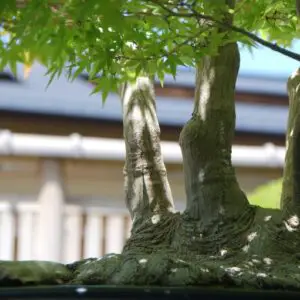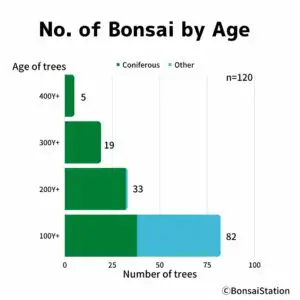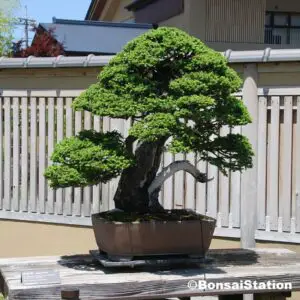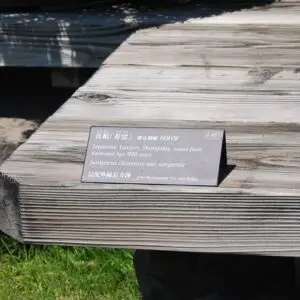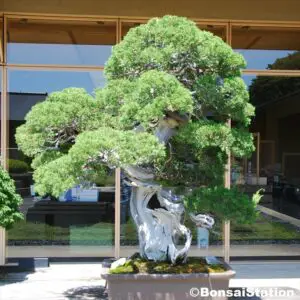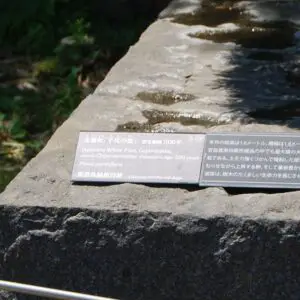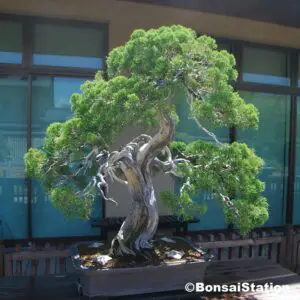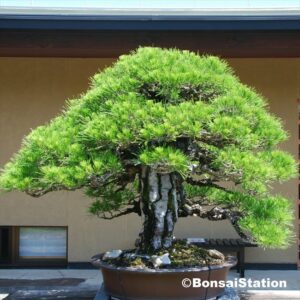It is remarkable to see a tree growing healthy in a shallow bonsai pot. In fact, a bonsai tree can stay alive for a very, very long time.
A bonsai tree can live more than 1000 years if it is cared for properly. It can live at least a few decades easily by an ordinary bonsai grower if it is repotted regularly, fertilized adequately, and pruned appropriately.
How to tell the age of a bonsai tree
Determining the age of a bonsai tree is very difficult. The most accurate way is to count the rings on the stump; the number of rings indicates the number of years the tree lived. But of course, this can only be done to a dead bonsai tree or it will kill the tree.
Other means such as measuring the size of the trunk or counting branch whorls (arrangement of branches from the trunk) can only be applied to trees that have grown naturally. A bonsai tree with a thick trunk is not necessarily old, and a thin one is not necessarily young. Depending on the style and how the tree is managed, even a pencil-like bonsai tree can be quite old.
Observing the characteristics of a tree is not helpful to determine its age as well because the appearance of bonsai trees changes significantly depending on the species, climate, and how they are managed. Also, a bonsai tree is deliberately managed to look like an old, ancient tree that has grown in nature for years.
In short, you cannot tell with accuracy how old a bonsai tree is, and the age of a bonsai tree you are shown is just an estimate unless the tree has grown from seeds or cuttings and a record has been kept since. If a bonsai tree is harvested from nature (“yamadori”) or grafted, the tree’s age is clearly unknown or undeterminable.
How long do bonsai trees live?
It is true that determining the age of a bonsai tree is difficult and the age is an estimate, but a bonsai tree can live a very long time, for sure.
A bonsai tree can live more than 1000 years if it is cared for properly. It can live a few decades easily even if it is managed by an ordinary bonsai grower. All you have to do is to repot regularly, fertilize adequately, get rid of pests and diseases frequently, and prune appropriately to manage its shape.
Oldest bonsai trees in Japan
There is no doubt that Japan is the center of bonsai art and we have numerous masterpieces of bonsai trees that have lived for a long period of time.
The Omiya Bonsai Art Museum, Japan, is the world’s first museum of bonsai that is operated publicly. The museum has a collection of 120 bonsai trees; about half are coniferous trees such as juniper and pines, with the other half deciduous, flower, and fruit trees. These trees are, of course, taken care of from top to bottom by bonsai masters on a daily basis.
Oldest bonsai trees
The top 5 oldest trees in the collection at the Bonsai Art Museum are as follows.
| Estimated age |
Species | Latin name | |
| 1 | 1000 | Spruce | Picea jezoensis var. jezoensis |
| 2 | 800 | Juniper | Juniperus chinensis var. sargentii |
| 3 | 500 | Japanse white pine | Pinus parviflora |
| 4 | 500 | Japanse white pine | Pinus parviflora |
| 5 | 450 | Japanse white pine | Pinus parviflora |
A 1000-year spruce bonsai is the oldest, followed by 800-year-old juniper bonsai, two 500-year-old Japanse white pines and a 450-year-old Japanse white pine bonsai.
Out of 120 bonsai trees in their collection;
- 82 are over 100 years old,
- 33 are over 200 years old,
- 19 are over 300 years old, and
- 5 are over 400 years old.
Of the 33 bonsai trees that are over 200 years old, 32 are either pinus or juniper (coniferous trees). Many of the trees that are less than 200 years old are deciduous, flower, or fruit trees. This is partly because of the natural lifespan of the trees. While pines and junipers can live over 1000 years in nature, many deciduous, flower, or fruit trees live a few hundred years at most.
In any event, the collection of bonsai trees at the Bonsai Art Museum shows that, with proper care, bonsai trees can live for a few hundred years.
1000-year-old spruce
※Click to enlarge
This spruce bonsai named Todoroki, the roar of the thunder, is estimated a 1000 years old. The center of the trunk died off, revealing a hollow. Along with shari (dead wood), the tree expresses the strength and the oldness of the tree in nature.
800-year-old juniper
※Click to enlarge
This Japanese juniper bonsai is 800 years old and has remarkable shari (dead wood) flowing from the trunk to the branches, contrasted with the gray bark and the green of the foliage.
500-year-old pine
※Click to enlarge
This Japanese white pine bonsai is estimated 500 years old. This is a very large human-size bonsai with an overall height of 5 feet (1.6m) and a width of 6 feet (1.8m).
Age of bonsai trees by species
The average estimated age of the collection of 120 bonsai trees at the Bonsai Art Museum is 165 years, with the oldest being 1000 years.
Average age differs largely from species to species, and generally speaking, coniferous trees live longer.
| Species | Average age | No. of trees |
| Spruce | 1000 Y/100 Y | 2 |
| Japanese juniper | 301 | 10 |
| Needle juniper | 300 | 1 |
| Pine | 198 | 49 |
| Japanese maple | 100 | 10 |
| Others | 112 | 48 |
| AVERAGE | 165 | 120 |
Japanese juniper
As cypress family, a Japanese juniper (Juniperus chinensis var. sargentii) can live for a very long time. In fact, one of the oldest Japanese juniper grown in nature is said to be around 1600 years old. As such, there are quite a few very old Japanese juniper bonsai trees, including an 800-year-old and three 350-year-old bonsai at the Museum.
Japanese juniper is native to northeast Asia (China, Japan, Korea and the Russian Far East) and one of the most common species used in bonsai because of its small needle-like foliage.
Pines
There are several pinus tree subspecies used in bonsai such as Japanese red pine (pinus densiflora), white pine (pinus parviflora), and black pine (pinus thunbergii). Pinus is also known for its long life. Of the 49 pinus tree bonsai at the Museum, 22 are over 200 years old, including two 500-year-old, one 450-year-old, one 380-year-old, three 350-year-old and four 300-year-old pinus bonsai trees.
Japanese maple
Japanese maple (Acer palmatum) in nature can live over 500 years. Although it is more difficult to keep them alive as bonsai than pinus, Japanese maple bonsai can live over 100 years.
If you are interested in how long mini bonsai trees live, please check the following post.


